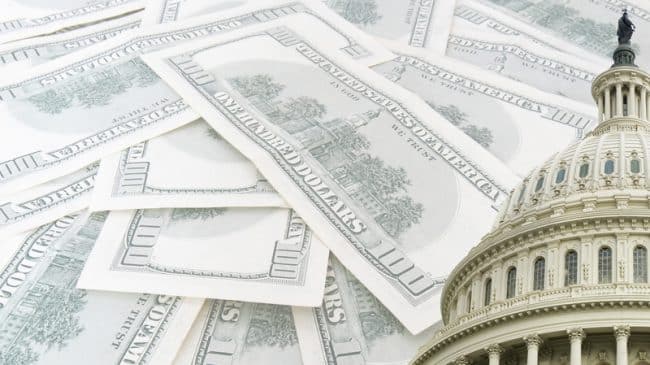Previous: 1. Agriculture > Taxpayer’s Guide > Next: 3. Armed Forces
Summary: Over $19 billion is set aside for the Commerce Department, Justice Department, NASA, the National Science Foundation, and other science agency programs.
>> Spending
$5.6 billion for Scientific Research Programs. Title II designates this money for scientific research and to enhance research facilities. The National Science Foundation will receive over $3 billion; NASA is allocated $1 billion; The National Institute of Standards and Technology get over $600 million; and NOAA will be given over $800 million-a third of which is for studying the weather.
All of these spending projects simply fund the general budget of the organizations. There is no specific direction for how the money is to be used. There was no analysis done to show the money was needed in these areas or how it would help the economy. The money given to NASA was simply for “Science,” “Exploration,” “Aeronautics,” and “Cross Agency Support,” with no corroborating research from NASA explaining what they need the money for. After being given the money, the space agency has proposed some uses for the money, such as climate change research.
$5 billion for Law Enforcement Programs. The majority of this money is for cities and counties to hire new officers. Some of the money has a specific target, including $50 million for the Internet Crimes Against Children initiative, and $40 million for the drug war along the southern border.
While it is important for law enforcement to be well funded, increasing taxpayer funding for the never-ending War on Drugs is not economically beneficial. A better economic stimulus would be to legalize the use and sale of marijuana and other narcotics, drawing tax revenues from their sale, and spending the drug war enforcement money on other government projects.
$4.7 billion for the Broadband Technology Opportunities Program. The National Telecommunications and Information Administration (NTIA) will create this new program to get broadband Internet service in all areas of the United States, increase service quality where broadband is weak, and ensure schools, libraries, police and fire departments, and hospitals have adequate Internet access. The program will work with the “Rural Development Broadband Program” to specifically target rural residential areas to stimulate the demand for broadband to try and increase economic growth and employment.
There has not been much analysis for how this will create economic growth, or if the money spent will generate equal or greater returns. This program is a political boon to representatives from rural areas who got this spending program piggybacked on a larger cause and didn’t have to debate the merit before all of Congress. Essentially, taxpayers in urban areas will now be subsidizing broadband access for rural areas.
$2 billion for the Edward Bryne Memorial Justice Assistance Grant Program. This program gives money to states and local governments to help combat drug trafficking, violent crime, and provide drug and alcohol treatment programs. The stimulus money will be added to the general program budget. Just like other law enforcement programs, large amounts of this money will go towards funding hurtful programs to the economy and society.
$1 billion for the 2010 Census Operating Budget. The Commerce Department, which conducts a nation-wide census every 10 years, is over budget in preparing for the 2010 census. This money will go into the general operating funds for the census that is already over budget.
$650 million for Digital TV Converter Coupons. The nation’s airwaves have switched to a completely digital transmission of television signals, meaning homes can no longer use just their “antennas” or “bunny ears” alone to watch TV. A box that converts the signal the antennas pick up is now necessary. This money will give additional funding to a program that is handing out coupons to get “digital-to-analog” converters at a reduced price.
This program is a spending project with no real link to economic stimulus. In fact, these coupons may hurt the economy because if individuals had to buy their own converter boxes, they may simply decide to spend a little bit more and buy a new TV that doesn’t need the technology adjustment.
$150 million for Economic Development Assistance Program Grants. This Commerce Dept. program was created in the 1960s to combat severe economic stagnation in urban and rural areas. The grants are specifically for fixing public facilities, providing more public services at the local level, and offering business development grants. These funds will be added to the program’s budget and distributed regionally based on unemployment and income levels.
>> Commentary
The items in Title II are a clear example of spending without much analysis as to how the spending will stimulate economic growth. In September 2008, Congress granted $400 million for the Economic Development Assistance Program through the “Consolidated Security, Disaster Assistance, and Continuing Appropriations Act.” How is it that they need $150 million more now?
The spending on these programs with virtuous causes-such as fighting crime-fails to see the ways it hurts private sector innovation. The money spent on Digitial TV boxes is one aspect of this problem. But there are more subtle impacts on local businesses. For instance, the Edward Byrne Memorial grant program will help law enforcement, a public good that will benefit everyone. But this grant also funds a “pretrial release” program that competes with the private sector bail industry. The stimulus money pits a taxpayer funded program against businesses instead of encouraging private sector industry. This waste of taxpayer money hurts local community economies and violates a general principal that the government should not compete with the private sector.
- Also see Reason videos on the Drug War:
- Defending Medical Marijuana
- Charlie Lynch Injustice
- The Case of Cory Maye
More from Reason on Commerce, Justice, and Science.
>> Government Recovery Websites
Department of Commerce: http://www.commerce.gov/Recovery/
Department of Justice: http://www.usdoj.gov/recovery/
National Science Foundation: http://www.nsf.gov/recovery/
NASA: http://www.nasa.gov/recovery/
Previous: 1. Agriculture > Taxpayer’s Guide > Next: 3. Armed Forces
Written by: Anthony Randazzo. Please email with any comments or corrections.
